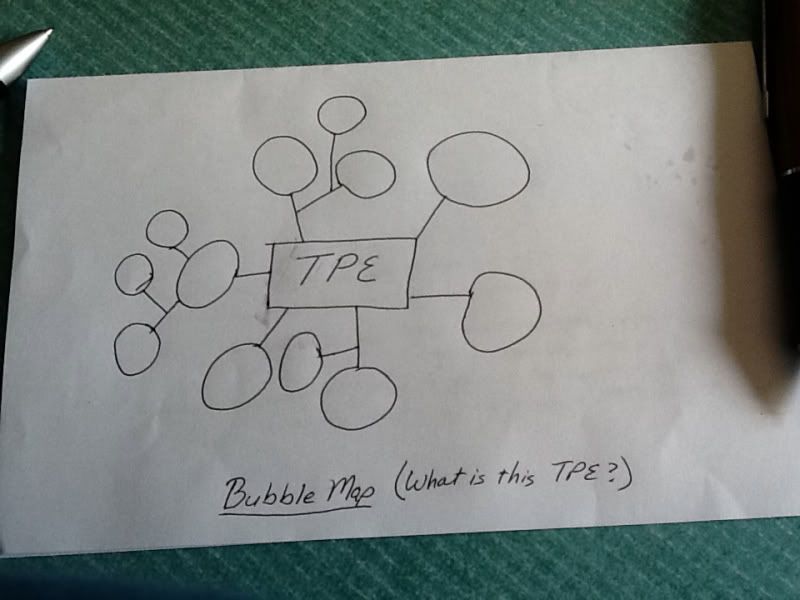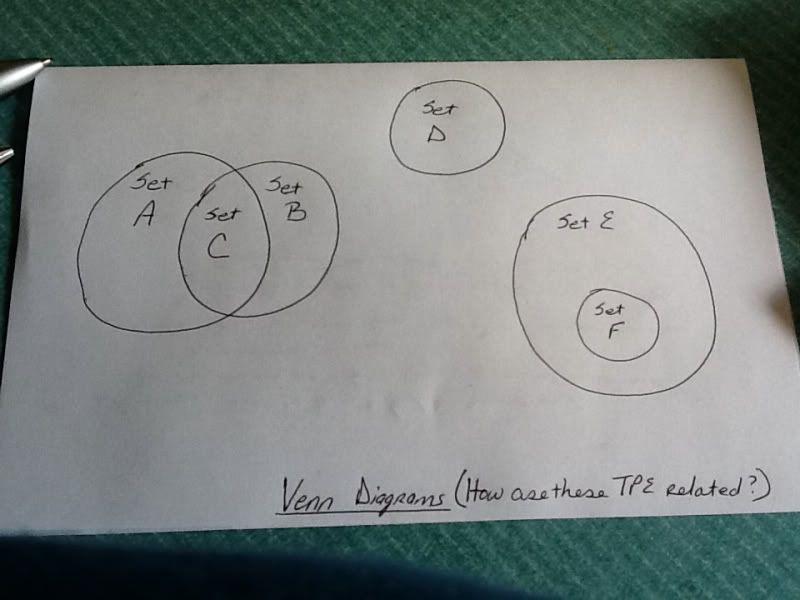Relationship between TPE attributes
Clearly defined, possibly readily observable
Gathered from mental constructs
(mental constructs guide which relationships are considered 'meaningful' vs which are 'noise')
Ti is often associated with ability to analyze. Analyzing is the process of breaking down into parts and studying their interrelationships. In this case, we are talking about breaking Se/Ne TPE down into their parts (attributes) and studying how those attributes relate...and thus draw conclusions about how the TPE are related.
Ti is often associated with classifying, categorizing, and hierarchies. Classifying, categorizing, and hierarchies are arranging/organizing TPE based on common or divisive attributes. When values are applied to these attributes, a grade or rank system is created, which creates the hierarchy of TPE.
One way of looking at it is:
Ne/Se are akin to a Bubble Map, with the TPE in the center, and attribute bubbles radiating out from it.

Ti is akin to Venn Diagrams.

When we look at this image, we are able to draw clear and obvious conclusions about the relationships between sets A-F. (a 'set' can be a class, a category, or a TPE)
- Some A are B. Not all A are B.
- Some B are A. Not all B are A.
- No D are A nor B.
- All C are A and B.
- All F are E.
- No D are F nor E.
The relationships between sets A-F are now clearly defined. The definition was based on similarities/differences between the attributes of the TPE.
---------------------
Socionics is a Ti + Ne system
Information Elements = Ne blobs, not well defined, and gathered from mental constructs
Information Elements = elements defined by their relations to each other
- Object (Ne, Se, Fe, Te)...............Field (Ni, Si, Fi, Ti)
- Static (Ne, Se, Fi, Ti)..................Dynamic (Ni, Si, Fe, Te)
- Explicit (Se, Si, Te, Ti).................Implicit (Ne, Ni, Fe, Fi)
- Involved (Se, Si, Fe, Fi)...............Abstract (Ne, Ni, Te, Ti)
- Continuous (Ne, Ni, Se, Si)..........Discrete (Fe, Fi, Te, Ti)
Such that Ti is defined as having the attributes of Field, Static, Explicit, Abstract, and Discrete.
Model A = functions defined by their relations to each other
- Strong (1,2,7,8)..............Weak (3,4,5,6)
- Mental (1,2,3,4)..............Vital (5,6,7,8)
- Accepting (1,3,5,7)..........Producing (2,4,6,8)
Such that our base function is defined as having the attributes of Strong, Mental, and Accepting.
------------
Having defined relationships between TPE leads to
- hierarchies, categories, classes
- clarity or exactitude of thought
- a sense of order and regularity
- systems of rules and regulations
Consider this:
In a work setting, you divide people up by what things/information they are working with, and what actions they will perform for that thing/info (their duties).
- Person A works with X, Person B works with Y, Person D oversees them both.
- X happens to Thing A, Y happens to Thing B, Person D insures these events occur.
- Person A works with Thing A, Person B works with Thing B, Person D oversees them both.
Because each relationship between TPE are clearly defined, it insures that rules and regulations are easier to implement to insure this structure. Everyone knows what his/her job is. Every needed event occurs. Since everyone's duties are clearly divided, noone will be stepping on each other's toes, right?
Many people will interpret this clear division as being 'rigid' and the person as being a 'stickler' for the rules.
Think of a logic puzzle. It has a set solution and it offers clues. If those clues are off, or if the structure of the solution is erred, the solver would likely wind up guessing, trial/error, or quitting in frustration. So remember this, how it feels to solve a logic puzzle that the writer screwed up on... Because that's a similar frustration that the Ti person will feel when you start fucking around with his puzzle....er structure.
So, you want to change the Ti person's mind about something? Convince Ti of something? Guess what...you'll have a far easier time if you reference their structure, (the relationships they've given between TPE), and show them how just a little bit of rearranging can allow them a new pov, and possibly more flexibility in their structure.
(oh wait...that would hold true for most people...oh, wait again...model A says every person has every element. We all have a bit of Ti in us. Some just more so than others.)
------------
Ti is often found in
- Geometry Proofs
- formal logic
- formal structures
- scientific classifications and systematizations (eg plant/animal kingdom hierarchies)
- creating and solving most logic puzzles
- the part of programming that defines the sets/categories/classes needed by the program
----------
Wanna experience Ti?
A site with some of my favorite logic puzzles is: http://www.kaser.com/index.html
(my favorites are the sherlock sets, the honeycomb, and the latin/greek squares)
(I'd never be able to create things like this...and I'm in awe of those who can.)
Another way is to grab a bunch of items and place them into a big enough space. Play around with different categories you can make from them. Name the categories with a descriptive term that will help remind you of the categories you created. Then create a set of Venn like diagrams to help guide you in figuring out how to define the relationships between each of those categories/sets. Chances are, if you do this with items you deal with everyday, or that have a special significance for you,...chances are you won't quite look at each one as you used to. They will now be linked with the other items according to the relationships you defined.
Now, I dare you to try that with a conceptual blob. (and no, I'm not doing this one,
 )
)

 Menu
Menu Categories
Categories Recent Articles
Recent Articles
 Tag Cloud
Tag Cloud
On my real type (EII) Aushura, Beebe
People can speculate and relate to multiple types but I see Fi/Te etc. two sides of the same coin so it is ultimately about how they ‘dualize’
necrosebud Today, 08:09 AM